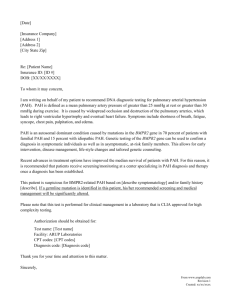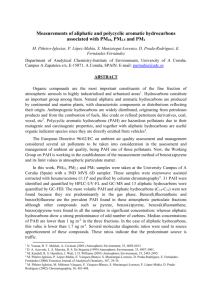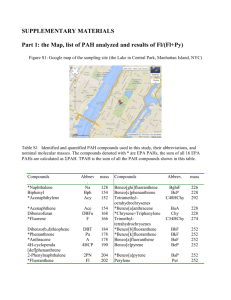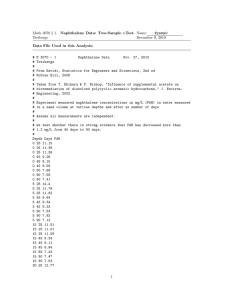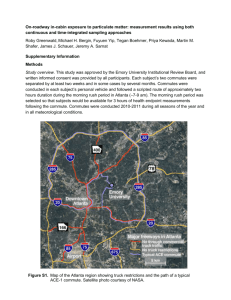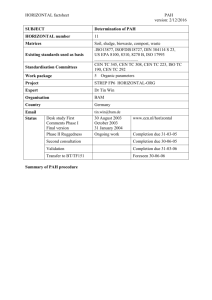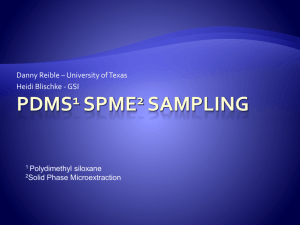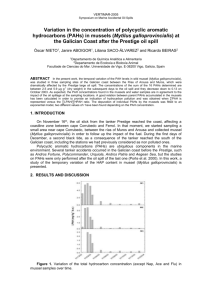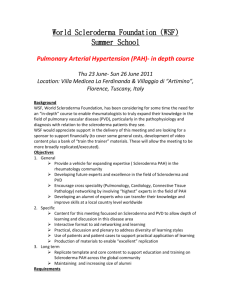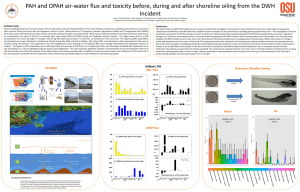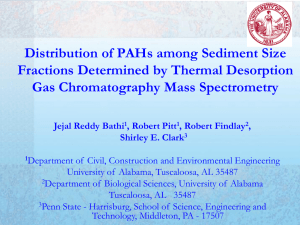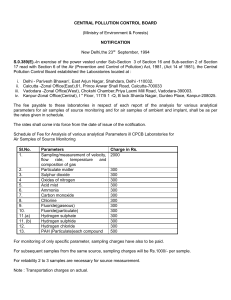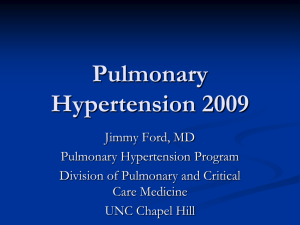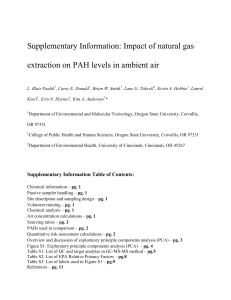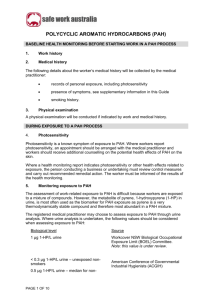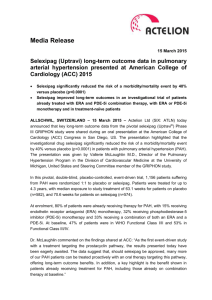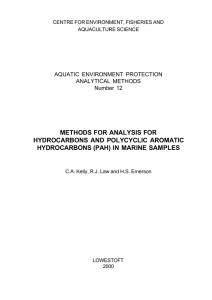УДК 542.06. SORPTION EXTRACTION OF PAH FROM SOLUTIONS
advertisement
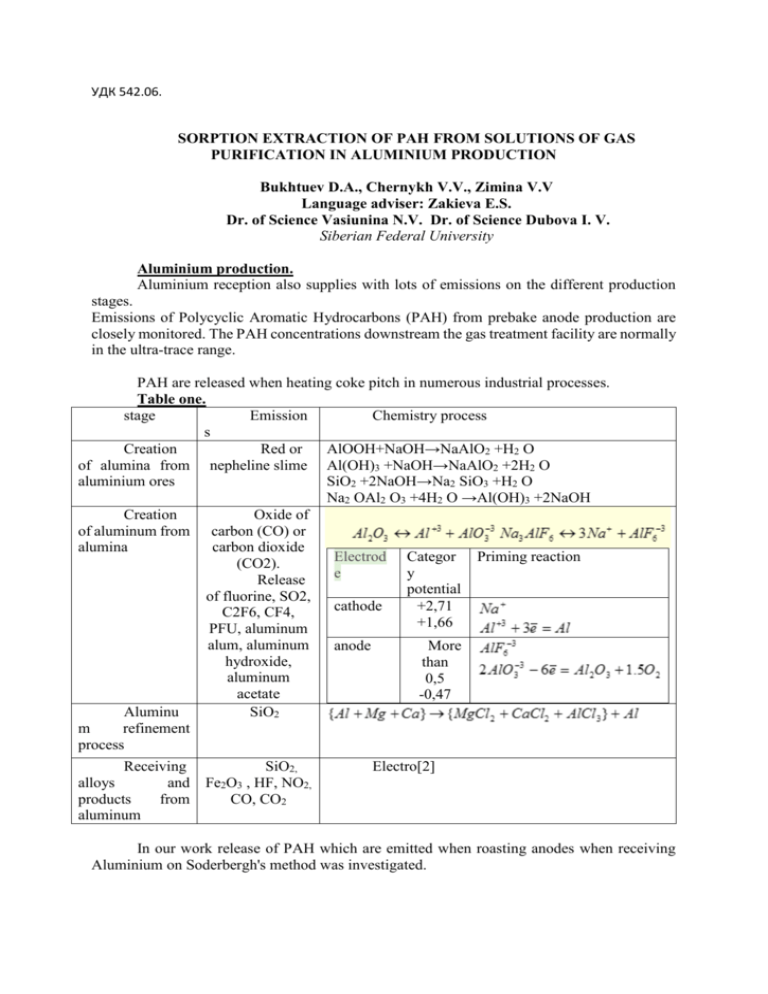
УДК 542.06. SORPTION EXTRACTION OF PAH FROM SOLUTIONS OF GAS PURIFICATION IN ALUMINIUM PRODUCTION Bukhtuev D.A., Chernykh V.V., Zimina V.V Language adviser: Zakieva E.S. Dr. of Science Vasiunina N.V. Dr. of Science Dubova I. V. Siberian Federal University Aluminium production. Aluminium reception also supplies with lots of emissions on the different production stages. Emissions of Polycyclic Aromatic Hydrocarbons (PAH) from prebake anode production are closely monitored. The PAH concentrations downstream the gas treatment facility are normally in the ultra-trace range. PAH are released when heating coke pitch in numerous industrial processes. Table one. stage Emission Chemistry process s Creation Red or AlOOH+NaOH→NaAlO2 +H2 O of alumina from nepheline slime Al(OH)3 +NaOH→NaAlO2 +2H2 O aluminium ores SiO2 +2NaOH→Na2 SiO3 +H2 O Na2 OּAl2 O3 +4H2 O →Al(OH)3 +2NaOH Creation Oxide of of aluminum from carbon (CO) or alumina carbon dioxide Electrod Categor Priming reaction (CO2). e y Release potential of fluorine, SO2, cathode +2,71 C2F6, CF4, +1,66 PFU, aluminum alum, aluminum anode More hydroxide, than aluminum 0,5 acetate -0,47 Aluminu SiO2 m refinement process Receiving alloys and products from aluminum SiO2, Fe2O3 , HF, NO2, CO, CO2 Electro[2] In our work release of PAH which are emitted when roasting anodes when receiving Aluminium on Soderbergh's method was investigated. Results of Monitoring uG/m3 After ahex-1 Acenaphtlene 0.71 Acenaphtylene <0.2 Benz[a]antracene <0.2 Benzo[b/j/k]fluoranthene 0.37 Benzo[ghi]perylene <0.2 Benzo[a]pyrene 3.12 Chrysene <0.2 Dibenz[a,h]antrhracene <0.2 Fluoranthene 1.14 Fluorene <0.2 Indeno[1,2,3-cd]pyrene <0.2 Naphthalene 19.6 Antrhracene/Phenanthrene 15.6 Pyrene 6.71 After ahex-2 0.73 <0.2 <0.2 0.62 <0.2 6.05 <0.2 <0.2 1.18 <0.2 <0.2 22.09 18.9 7.84 Before ahex 8.79 11.2 4.85 <0.2 10 15 0.34 98.1 5.5 0.22 84.3 59.4 Harmful effects of PAH on a human body There are several reported health hazards related to the different PAH components. Such as respiratory effects and decreased fertility. In addition, they are classified as Group B2 carcinogenic substances according to EPA. What means EPA? The United States Environmental Protection Agency (EPA or sometimes USEPA) is an agency of the U.S. federal government which was created for the purpose of protecting human health and the environment by writing and enforcing regulations based on laws passed by Congress. The EPA was proposed by the President Richard Nixon and began operation on December 2, 1970, after Nixon signed an executive order. The agency is led by its Administrator, who is appointed by the president and approved by Congress. The current administrator is Gina McCarthy. Real conditions of continuous monitoring of emissions of PAH. The emissions of PAH components are strictly regulated by national governments, as well as international rules. Control on the emissions as well as process tuning to reduce the emissions is therefore essential. In order to analyze the entire range of PAH components multiple technologies will have to be applied. A potential procedure is to split a side stream from the off gas, in fractions suitable for the different analysis technologies, capture them and finally analyze them. Methods of analyze. Nowadays were found several methods of PAH emissions analyze, they are: Fourier Transformed Infra Red Spectroscopy (FTIR) Gas Chromatography(GC) Mass Spectrometry(MS) Liquid Chromatography(LC) FTIR is based on adsorption or emission of light waves in the infrared spectra, and is a well-known technology. Different molecules will adsorb the IR radiation at different wave lengths and to different extent. This gives accurate and reproducible analysis, and is compact and robust enough to easily be transformed into the field. GC/MS is a powerful method to analyze gas samples. The gas is first passed through a traditional GC column wich is a long thin column packed with a substrate that interacts differently with different gas components. In GC analysis the components are separated by the time they use to emerge from the column. Several detectors are available for GC analysis of which Thermal Conductivity (TC) perhaps being the most common. In a GC/MS a mass spectrometer (MS) is used as a detector. In a MS, the gas are passed through an electron beam, which ionizes the components in the gas. The molecules are then passed through a vitiating electric field and the weight of the molecules can be determined based on how much their path is bent when passing through the field. Experiment Methodology The question of a choice of the most qualitative adsorbent for catching of PAH in systems of gas purification still is actual. Experiments with MN200 adsorbent use were made. For performance of experience on a support fixed a flask of a cylindrical form with an additional opening from below, from above established a funnel with the filter on which MN200 is filled. Attached a silicone tube through which, by means of the pump, technological solution of gas purification passes to a funnel to the lower opening of a flask. By means of this installation solution is cyclically filtered through MN200 which in turn catches PAH. It is skilled it is established that time of one cycle makes 1 minute 25 seconds. Experiments were repeated serially from 2 to 24 cycles. After each experience solution went on the analysis of a liquid chromatography. The main objective of experience was establishment of quantity of cycles which would allow to adsorb as much as possible PAU from gas purification solution. Range of PAH. Acenaphthene Acenaphtylene Anthracene Benz[a]antracene Benzo[b]fluranthene Benzo[k]fluranthene Benzo[ghi]perylene Benzo[a]pyrene Chrysene Dibenz[a,h]antrahracene Fluoranthene Fluorene Indeno[1,2,3-cd]pyrene Naphthalene Phenanthrene Pyrene References [1] «Light Metals 2014» Edited by John Grandfield TMS (The Minerals, Metals & Materials Society), 2014 [2] «Processing of waste of aluminum production 2004» Edited by Culickov B.P and Istomin S.P.

